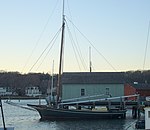Mystic River (Connecticut)
Connecticut placenames of Native American originEstuaries of ConnecticutLong Island SoundMystic, ConnecticutRivers of Connecticut ... and 1 more
Rivers of New London County, Connecticut

The Mystic River is a 3.4-mile-long (5.5 km) estuary in the southeast corner of the U.S. state of Connecticut. Its main tributary is Whitford Brook. It empties into Fishers Island Sound, dividing the village of Mystic, Connecticut between the towns of Groton and Stonington. Much of the river is tidal. The Mystic River was the location of three large shipbuilding firms during the 19th-century, and it is now the home of the Mystic Seaport maritime museum. The name Mystic is derived from the Pequot term "missi-tuk", describing a large river whose waters are driven into waves by tides or wind, according to the Mystic River Historical Society.
Excerpt from the Wikipedia article Mystic River (Connecticut) (License: CC BY-SA 3.0, Authors, Images).Mystic River (Connecticut)
Water Street,
Geographical coordinates (GPS) Address Nearby Places Show on map
Geographical coordinates (GPS)
| Latitude | Longitude |
|---|---|
| N 41.349722222222 ° | E -71.970277777778 ° |
Address
Mystic River
Water Street
06388
United States
Open on Google Maps








